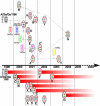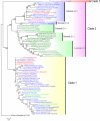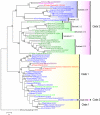A(H5N1) Virus Evolution in South East Asia
- PMID: 21994553
- PMCID: PMC3185531
- DOI: 10.3390/v1030335
A(H5N1) Virus Evolution in South East Asia
Abstract
Highly Pathogenic Avian Influenza (HPAI) H5N1 virus is an ongoing public health and socio-economic challenge, particularly in South East Asia. H5N1 is now endemic in poultry in many countries, and represents a major pandemic threat. Here, we describe the evolution of H5N1 virus in South East Asia, the reassortment events leading to high genetic diversity in the region, and factors responsible for virus spread. The virus has evolved with genetic variations affecting virulence, drug-resistance, and adaptation to new host species. The constant surveillance of these changes is of primary importance in the global efforts of the scientific community.
Keywords: H5N1 virus; South East Asia; avian influenza; evolution.
Figures




Similar articles
-
Genetic characterization and pathogenicity assessment of highly pathogenic H5N1 avian influenza viruses isolated from migratory wild birds in 2011, South Korea.Virus Res. 2011 Sep;160(1-2):305-15. doi: 10.1016/j.virusres.2011.07.003. Epub 2011 Jul 12. Virus Res. 2011. PMID: 21782862
-
The evolutionary dynamics of highly pathogenic avian influenza H5N1 in south-central Vietnam reveals multiple clades evolving from Chinese and Cambodian viruses.Comp Immunol Microbiol Infect Dis. 2015 Oct;42:21-30. doi: 10.1016/j.cimid.2015.08.001. Epub 2015 Aug 28. Comp Immunol Microbiol Infect Dis. 2015. PMID: 26577194
-
Evolution of highly pathogenic avian H5N1 influenza viruses and the emergence of dominant variants.J Gen Virol. 2010 Aug;91(Pt 8):1984-1995. doi: 10.1099/vir.0.020750-0. Epub 2010 Apr 14. J Gen Virol. 2010. PMID: 20392897
-
Unique Infectious Strategy of H5N1 Avian Influenza Virus Is Governed by the Acid-Destabilized Property of Hemagglutinin.Viral Immunol. 2017 Jul/Aug;30(6):398-407. doi: 10.1089/vim.2017.0020. Epub 2017 Jun 27. Viral Immunol. 2017. PMID: 28654310 Review.
-
[Evolution of avian influenza viruses H5N1 (1997-2004) in southern and south-eastern Asia].Vopr Virusol. 2005 Jul-Aug;50(4):11-7. Vopr Virusol. 2005. PMID: 16104516 Review. Russian.
Cited by
-
Environment: a potential source of animal and human infection with influenza A (H5N1) virus.Influenza Other Respir Viruses. 2012 Nov;6(6):442-8. doi: 10.1111/j.1750-2659.2012.00338.x. Epub 2012 Feb 17. Influenza Other Respir Viruses. 2012. PMID: 22340982 Free PMC article.
-
Emergence, migration and spreading of the high pathogenicity avian influenza virus H5NX of the Gs/Gd lineage into America.J Gen Virol. 2025 Apr;106(4):002081. doi: 10.1099/jgv.0.002081. J Gen Virol. 2025. PMID: 40279164 Free PMC article. Review.
-
Efficient Inhibition of Avian and Seasonal Influenza A Viruses by a Virus-Specific Dicer-Substrate Small Interfering RNA Swarm in Human Monocyte-Derived Macrophages and Dendritic Cells.J Virol. 2019 Feb 5;93(4):e01916-18. doi: 10.1128/JVI.01916-18. Print 2019 Feb 15. J Virol. 2019. PMID: 30463970 Free PMC article.
-
Genomic surveillance of influenza A virus in live bird markets during the COVID-19 pandemic.Vet World. 2025 Apr;18(4):955-968. doi: 10.14202/vetworld.2025.955-968. Epub 2025 Apr 23. Vet World. 2025. PMID: 40453955 Free PMC article.
-
Highly pathogenic influenza A(H5N1) virus survival in complex artificial aquatic biotopes.PLoS One. 2012;7(4):e34160. doi: 10.1371/journal.pone.0034160. Epub 2012 Apr 13. PLoS One. 2012. PMID: 22514622 Free PMC article.
References
-
- Kruy SL, Buisson Y, Buchy P. Asia: avian influenza H5N1. Bull Soc Pathol Exot. 2008;101:238–242. - PubMed
-
- World Health Organisation. Cumulative Number of Confirmed Human Cases of Avian Influenza A/(H5N1) Reported to WHO, 21 April 2009. See: http://www.who.int/csr/disease/avian_influenza/country/cases_table_2009_.... Accessed on 22 April 2009.
-
- World Health Organisation. H5N1 avian influenza: timeline of major events. See http://www.who.int/csr/disease/avian_influenza/ai_timeline/en/index.html. Accessed on 12 June 2009.
-
- Li KS, Guan Y, Wang J, Smith GJD, Xu KM, Duan L, Rahardjo AP, Puthavathana P, Buranathai C, Nguyen TD, Estoepangestie ATS, Chaisingh A, Auewarakul P, Long HT, Hanh NTH, Webby RJ, Poon LLM, Chen H, Shortridge KF, Yuen KY, Webster RG, Peiris JSM. Genesis of a highly pathogenic and potentially pandemic H5N1 influenza virus in eastern Asia. Nature. 2004;430:209–213. - PubMed
-
- OIE World Organisation for Animal Health. Avian influenza: H5N1 timeline. See: http://www.oie.int/eng/info_ev/en_AI_factoids_H5N1_Timeline.htm. Accessed on 12 June 2009.
LinkOut - more resources
Full Text Sources

